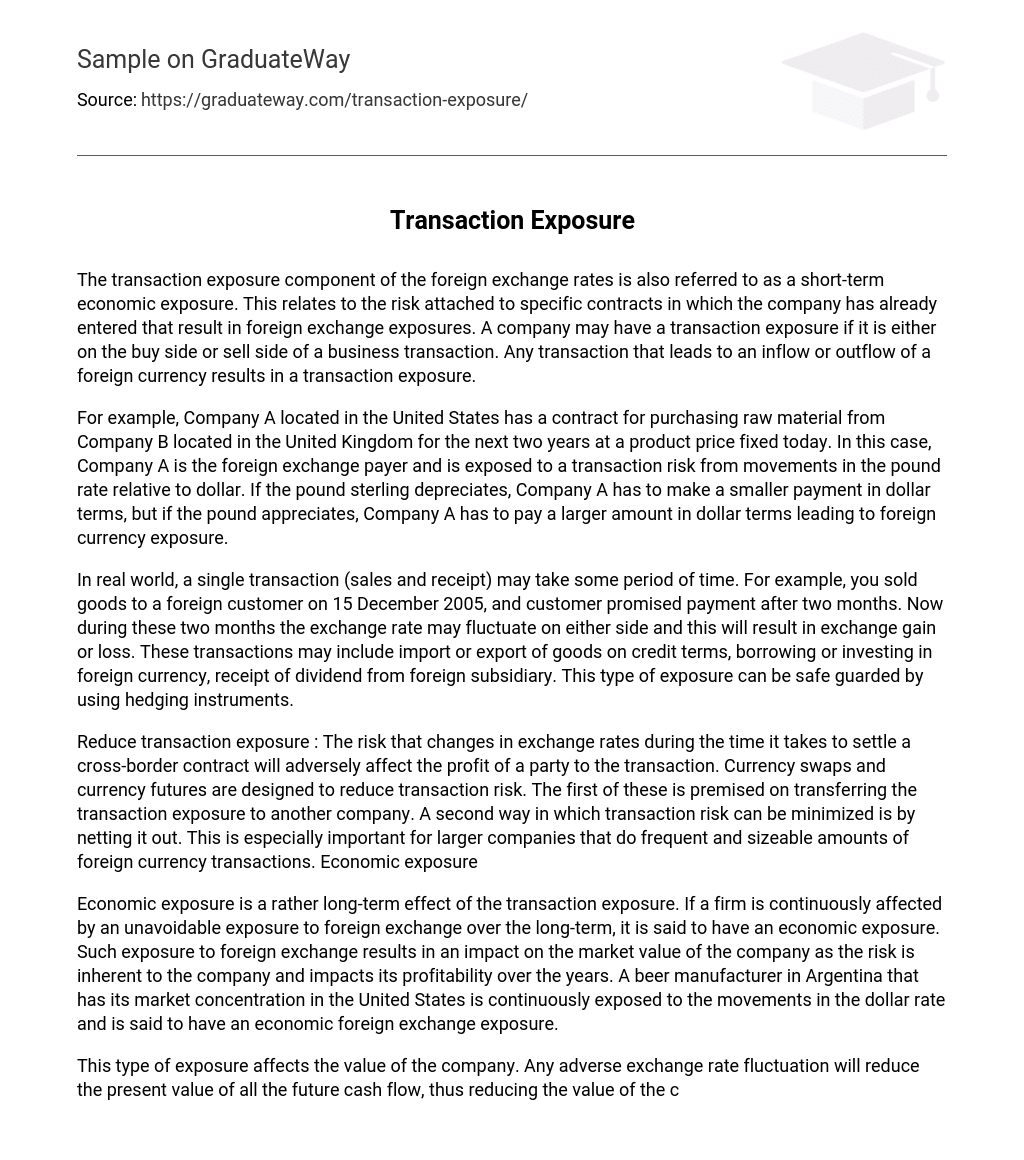The transaction exposure component of the foreign exchange rates is also referred to as a short-term economic exposure. This relates to the risk attached to specific contracts in which the company has already entered that result in foreign exchange exposures. A company may have a transaction exposure if it is either on the buy side or sell side of a business transaction. Any transaction that leads to an inflow or outflow of a foreign currency results in a transaction exposure.
For example, Company A located in the United States has a contract for purchasing raw material from Company B located in the United Kingdom for the next two years at a product price fixed today. In this case, Company A is the foreign exchange payer and is exposed to a transaction risk from movements in the pound rate relative to dollar. If the pound sterling depreciates, Company A has to make a smaller payment in dollar terms, but if the pound appreciates, Company A has to pay a larger amount in dollar terms leading to foreign currency exposure.
In real world, a single transaction (sales and receipt) may take some period of time. For example, you sold goods to a foreign customer on 15 December 2005, and customer promised payment after two months. Now during these two months the exchange rate may fluctuate on either side and this will result in exchange gain or loss. These transactions may include import or export of goods on credit terms, borrowing or investing in foreign currency, receipt of dividend from foreign subsidiary. This type of exposure can be safe guarded by using hedging instruments.
Reduce transaction exposure : The risk that changes in exchange rates during the time it takes to settle a cross-border contract will adversely affect the profit of a party to the transaction. Currency swaps and currency futures are designed to reduce transaction risk. The first of these is premised on transferring the transaction exposure to another company. A second way in which transaction risk can be minimized is by netting it out. This is especially important for larger companies that do frequent and sizeable amounts of foreign currency transactions. Economic exposure
Economic exposure is a rather long-term effect of the transaction exposure. If a firm is continuously affected by an unavoidable exposure to foreign exchange over the long-term, it is said to have an economic exposure. Such exposure to foreign exchange results in an impact on the market value of the company as the risk is inherent to the company and impacts its profitability over the years. A beer manufacturer in Argentina that has its market concentration in the United States is continuously exposed to the movements in the dollar rate and is said to have an economic foreign exchange exposure.
This type of exposure affects the value of the company. Any adverse exchange rate fluctuation will reduce the present value of all the future cash flow, thus reducing the value of the company. It is difficult to measure the dollar value effect on the value of the firm. Reduce economic exposure : Most large companies attempt to minimize the risk of fluctuating exchange rates by hedging with positions in the forex market. Companies that do a lot of business in many countries, such as import/export companies, are at particular risk for economic exposure.
Translation exposure Translation exposure of foreign exchange is of an accounting nature and is related to a gain or loss arising from the conversion or translation of the financial statements of a subsidiary located in another country. A company such as General Motors may sell cars in about 200 countries and manufacture those cars in as many as 50 different countries. Such a company owns subsidiaries or operations in foreign countries and is exposed to translation risk.
At the end of the financial year the company is required to report all its combined operations in the domestic currency terms leading to a loss or gain resulting from the movement in various foreign currencies. When a business has several subsidiary located in different foreign land, then it needs to consolidate its financial results of overall operations. Translation exposure effects the financials of the group when it translates its assets, liabilities and income to home currency from various currencies.
The widely used mean of protecting against translation exposure is known as balance sheet hedging. In this method, assets and liabilities are matched of offset in order to reduce the net effect of translation. Reduce translation exposure : This poses a serious threat for companies conducting business in foreign markets. Exchange rates usually change between quarterly financial statements, causing significant variances between the reported figures. Companies attempt to minimize these transaction risks by purchasing currency swaps or hedging through futures contracts





